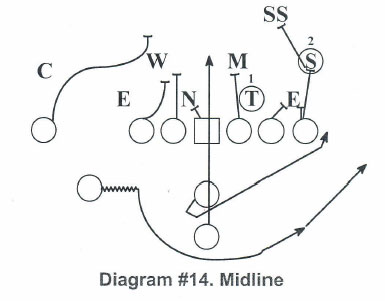|
Pistol Precepts and Zone Insights By: James Vint - Coronado HS (TX) Originally Published- Nike 2013 Coach of the Year Clinics Clinic Notes - by Earl Browning
We had to sit down and think about some things. We talked to the head coach and figured out we might be able to run some option football. We became an l-formation team running the midline, load veer, isolation, toss sweep, and trap. On occasion, we ran some Power plays and threw the ball 5 or 6 times a game. One year we opened it up and threw the ball eleven times in a game. We had some success and went to the playoffs for the first time in school history. The problem was when we got to the playoffs, we got spanked. We could not stand up physically with the team we played. We started playing with the spread in the earlier 2000. Art Briles was running the zone read at Stephenville High School in Texas before anyone ever heard of it. Jerry Campbell came up and helped us install the zone read in our offense. We had success with the zone read but defenses start to play games with the location of our running back. Whichever side you set him on they ran games to that side. We decided since people were keying where we set the back, we would put him behind the quarterback. in 2006, we got into the pistol full time. What is the Pistol?
The offense can be whatever you want it to be. For us the pistol is a back behind the quarterback in the shotgun set. We can align any number of backs in the backfield at any position. That kept defenses from reading the set back and calling their defense. In the shotgun, everything seemed to go east and west instead of north and south. We thought we could get in the l-formation with the quarterback under the center and get the downhill type of running we felt we needed. However, when we put the quarterback under the center, everyone knew what we were going to do. We were going to run power, isolation, and the toss. When we were in the shotgun, we ran zone read and speed option plays. We thought we had a multiple offense and would be hard to defend. When I talked to our defensive coordinator he told me we were not that hard to defend. If we were in the l-formation they played us one way, when we went to the spread, they played us another way.
When we got in the shotgun with the pistol the defense did not know what type of play we were going to run. Now the quarterback could take the snap and hand it off to the tailback as he did in the I-formation. Another thing it did was to help us in the passing game. [coach the quarterbacks and it is easier to teach a three-step drop than it is to teach a five-step drop. If we already have some depth in the passing game, it was going to help us be more diverse. When we go into the pistol we were still a run first team. However, we could effectively throw the ball 25-30 times a game. You can be effective in the quick passing game even if you do not have a good quarterback. In the I-formation, the tailback is seven yards from the line of scrimmage. When we were under center in an I-formation, the defense loaded the box and the safety played seven yards off the line of scrimmage. When we went to the pistol, that same team played a five and half defender box. Now we can run the football better. We are going through a deal now to create our formations. I have always wanted it to be simple when we used multiple formations. We have five formations. We designate them by using R and L words to mean right and left. Formations
The words in the formation tell the Y-receiver where to align. The Y does not have to be a tight end. It could be your third back or third receiver. We call our personnel and they go on the field. We may call 21, 30, or 10. When we get on the field with 30 personnel, we have three running backs on the field with no tight end. We align the fullback by using numbers. The even numbers go to the right and the odd numbers go to the left. They are the same positions on difference sides of the ball. The 011 position is the same position. The 0 is to the right and 1 is to the left. The 011 position is a sniffer position 1 yard off the line in the guard-tackle gap.
The 213 position is the halfback position at the quarterback depth. The 415 position is a wing set 1 X 1 off the end man on the line of scrimmage. The 6/7 is the slot position splitting the distance between the tackle and wide receiver. The 8/9 aligns the fullback as the widest receiver. (Diagram#1) Our base formation is Ron-7. Ron is the twins-formation with the Y-receiver in the right slot position splitting the difference between the tackle and Z-receiver. The number 7 tells the fullback to align in the number 7 position, which is the slot position to the left side. He splits the difference between the tackle and the X-receiver to the left. The fullback in our offense is not a traditional fullback. He is a hybrid player, which makes him part fullback and part receiver. We call that position the H-back. The only formation that needs an explanation is the bone-set. (Diagram #2) If we call Ron-3, the formation has a small adjustment. Ron-3 is a twin formation with the H-back set in the halfback position to the left of the quarterback. The word "bone" brings the Y-receiver into the halfback position to the right of the quarterback. That gives us a three-back look with the quarterback in the shotgun and the pistol behind him.
The thing I like about this is you can run anything you want to run in the pistol. We are a zone read team but we do many other things out of the pistol. Our base plays are our inside and outside zone reads. When we went to the pistol, we started with what we knew. We started with the midline, veer, isolation, toss, and trap. We wanted to run a power play so we used the counter trey. The first year we installed the pistol, we put in more than we needed. Since then we narrowed it down. We run the inside and outside zone, jet sweep, and rocket toss. We run the power play with 15 variations with one blocking scheme. The last play we run is the midline. We run the plays repeatedly and it looks like a ton of different plays. The first year we got into the zone read, not many people were running it. Everyone is running that play now and I am glad because it is good stuff. When we went to the pistol, defenses stop playing games to our read side. With the back behind the quarterback they did not know which side was the read side. I am not going to waste a lot of time with our blocking scheme but we are a count team. (Diagram #3) We use zone blocking, which means we block an area rather than a man, but we still count the defenders. We number from the center to the outside 0, 1, 2, and 3. If the center comes to the line of scrimmage and a defender is aligned on his nose that defender is 0.
We run the zone and zone read with the same blocking scheme. The difference between the zone and zone read is the zone is a give to the tailback and the quarterback runs a boot fake. On the zone read the quarterback reads a defender, and gives or pulls the ball off the reaction of his read. The reason we have two plays from this one play is the play of the defense. If you have a zone read play only, the defense will force the quarterback to pull the ball every time because they do not want the tailback carrying the ball. We run the zone play and give the ball to the tailback regardless of what the defensive end does. Our goal is to get our best player the football. On the zone play, we work a covered/ uncovered concept. The offensive linemen work in tandem on two defenders. If the play is an inside zone play, the covered lineman's landmark is the playside number on the jersey of the defender. When we talk about a landmark that is where the offensive blacker has to get his back knee. We do not teach putting the helmet to the landmark. We feel if we teach that all the linemen will do is to lean into the defender. If they get the inside knee to the landmark, the feet will be in position to block. We want them to keep the shoulders as square as possible. We do not want the shoulders at a 45 degree angle. Their shoulders should be at a 20 degree angle. That means the shoulders are almost parallel to the line of scrimmage. An ace call is a tandem block between the center and playside guard. The center's rule is A-gap. He steps into his A-gap and keys the 3-technique defender. If the 3-technique defender is moving away, his rule is to climb to the linebacker. The coaching point is for the center not to vacate the line of scrimmage too quickly. If he climbs to the linebacker immediately and the ball folds into the hole, the 3-technique will fall back into the hole and make the tackle. The center wants to step and punch the 3-technique onto the guard's block. He does not have to worry about the linebacker. That linebacker will come into the A-gap. If the linebacker does not fill, the ball will hit home free. He cannot get in a hurry to climb. The quarterback takes the snap, opens at a 45 degree angle, rolls back, and gives the ball to the tailback. We do it that way because we want the quarterback with his back to the line of scrimmage when he hands the ball off. He has the ball in two hands, and rolls back, and with one hand places the ball into the tailback's pocket. The tailback is three yards behind the quarterback. On the snap of the ball he takes a zone step to let the quarterback catch the ball. He crosses over, takes the ball, and is downhill to the line of scrimmage. If you do not get another thing from this lecture, listen to what I say about the pocket of the tailback. The tailback places his thumb against the sternum of his chest with the palm almost under his chin. That gives the quarterback a deep soft pocket to place the ball. It is the quarterback's responsibility to put the ball in the pocket. If the tailback pins his thumb against his sternum, the elbow is up and out of the way. (Diagram #4) There is no perfect football play. I went through our tapes looking at every play we blocked perfect this year. I am still looking for it. In our offense we use a bunch of tags. When we run the zone play without the read, we have to find a way to secure the backside C-gap. (Diagram #5) That keeps the backside end from running the play down from behind. We use the H-back to block back on the defensive end. His rule is to seal the backside. We can align him in any number of places. Most of the time we motion the H-back into position to block the defensive end.
The coaching point for the backside seal is for the blocker to hug the line of scrimmage. He has to take on the defensive end with an inside/ out block. If he does not get tight to the line of scrimmage, he cannot make the block. We can run the play without sealing the backside and get away with it. We can also run a bootleg or reverse without blocking the crashing end. There are a number of ways to keep him honest but the defense wants to crash the end more than keep him home. We can call the inside zone play with a "bend" tag. (Diagram #6) The bend play means the H-back is going to block the backside inside linebacker. We chart the people that make tackles during a game. If the backside linebacker is making tackles on the inside zone play, we call "bend." The playside linemen block the inside zone play. The backside blocks solid. They are blocking man-to-man on their defenders. In our zone read concepts, we have three blocking tags that give us some options. (Diagram #7) We call Boss, Bob, and Bison. We can run the inside zone many different ways. It takes us three days to get the inside zone package installed. Once we get that in, we have the entire offense installed essentially. The "Boss" call is the H-back on the strong safety. That is the fourth defender to one side. The "Bob" call is back on backer, which is the isolation play. The "Bison" call is backside isolation play.
Another thing we do to keep the backside end at home is to run a fake reverse. We set the formation and run "Zip" motion into the formation. It is like jet sweep motion. He has no other responsibility. If the defensive end runs upfield, we do not block him. The companion play of the inside zone play is the inside zone read. (Diagram #8) This is where the fun begins because I am an option coach. would rather read a defender than block him. The play is inside zone to the right. The quarterback reads the left defensive end. The offensive line blocks inside zone right. The quarterback steps with his right foot and pushes off the midline to 4:30 on the clock face. He steps back at a 45 degree angle with his left foot. We do not want the back running straight downhill.
The quarterback will have questions about when to pull the ball. The quarterback has to understand the differences between squeeze and chase. If the defense closes to the inside in the C-gap, that is not a chase. If he squeezes down the line, that is not a chase. For the quarterback to pull the ball, the defensive end has to turn his shoulder to the inside and run to the tailback. If the defensive end does that, the quarterback pulls the ball and runs out the backside. We tell the quarterback, if the defensive end takes three steps to the inside, he pulls the ball. If he thinks the defensive end can tackle the back, he pulls the ball. Defenses scheme to force the pull and play the quarterback with a scraping linebacker. (Diagram #9)
The deuce blocker can be a flexed tight end or an offset H-back. The deuce blocker cross the face of the inside zone mesh and keys the defensive end. He reads the same thing the quarterback reads. If the defensive end comes up the field, the quarterback gives the ball to the tailback on the inside zone. The deuce blacker goes inside of the defensive end and up the field to block the Will linebacker, or he may get all the way to the safety. If the defensive end chases the tailback, the quarterback pulls the ball. The deuce blocker wraps around the defensive end and blocks the Will linebacker. The key to the play is the deuce blocker has to understand leverage and landmarks. The deuce blocker hugs the line of scrimmage and reads the defensive end. If the defensive end squeezes, the deuce block is outside. If the defensive end is outside, the deuce blocker is inside. It looks simple but you must drill it repeatedly to get the deuce under the mesh and in a position to wrap up on the linebacker. This is something you can teach without a ball in the weight room. The other thing we can do with the deuce block is make a "deuce-triple" call. (Diagram #10)
A variation on the same play is the "cowboy" call. The number 2 receiver to the read side becomes the pitch back on the option. The quarterback reads the defensive end. If he chases the tailback, the quarterback pulls the ball and option off the Will backer. His pitch-back is the slot receiver. The slot receiver backpedals inside, plants, and gets into the pitch relationship with the quarterback. It takes time to get it right but do not over coach this technique. Let them be athletes. This is just one more thing the defense has to defend. We have ways to read the 1-technique, 3-technique defender, or a linebacker. We use a tag on the play. If we say "tuna", we read the defensive tackle. We call "Bama" and read the linebacker. If the defender playing one of those positions is whipping our tail, we read him. If a backer is making the plays we call "Bama", read him, and run away from him. We run it off the trap series. We pull the guard and read the backer. The offensive tackle uses a solid block on the defensive end. If the linebacker follows the pulling guard to the playside, the quarterback pulls the ball and runs where the linebacker left. We can do the same thing with the "tuna" call. This is a better call. The 3-technique aligns on the offensive guard. When the guard pulls toward the center, they coach the 3-technique defender to get in his hip pocket and follow him. If he does, the quarterback pulls the ball and run inside where the 3-technique vacated Some teams like to crash the end and attack the mesh of the quarterback and tailback. When they attack the quarterback in the mesh area, we give the ball to the tailback. He will not tackle the back because he is too far up the field.
The first one is the two-back power. (Diagram #11) We do not get under the center. We keep the quarterback at four and half yards and do not move him toward the line. He takes the football, rolls back, and gives the ball to the tailback.
When we run the power, we like to read the backside tackle. (Diagram #12) The quarterback takes his read steps for a backside read. The tailback takes his read steps to get in position to take the bail. The quarterback reads the defender playing the backside B-gap. If he gets in the hip pocket of the pulling guard, the quarterback pulls the ball and runs into the B-gap. The backside tackle turns out on the backside 5-technique defender.
If the defender widens the quarterback gives the ball to the tailback. If he squeezes inside, the quarterback pulls the ball and the fullback leads him around the corner. We tell the quarterback in any read situation, if he gets confused, pull the ball and make something happen.
I want to show you the midline. (Diagram #14) We run so much wide zone we must have something up the middle. In the odd front defense, the quarterback reads the 5-technique defender. If the defender reaction is squeeze and chase, the quarterback pulls and replaces. The quarterback pushes off the midline and steps at 6:00. The tailback is directly up the center's butt. From the pistol, the back can break the ball almost anywhere. If the tailback stays on path, the play can flip out the back door. The playside guard takes his best release. If he has a 3 or 5-technique defender, he releases inside to the linebacker. If he has a 2 or 2i-technique, he releases outside the defender. Against a 2i-technique, the quarterback thinks pull, but he still reads the play. The 2i-technique can always play outside into the guard. I see my time is up. Thank you very much. |
|
|
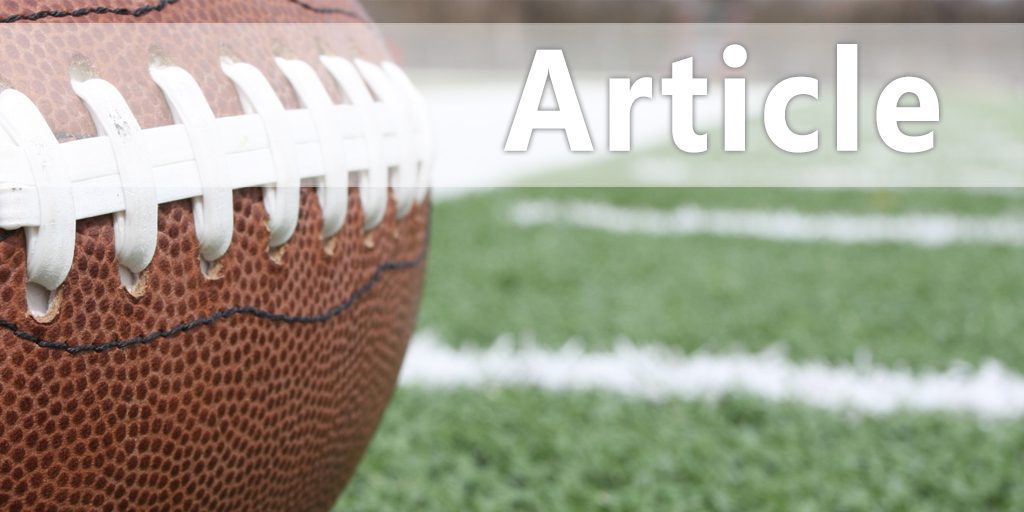



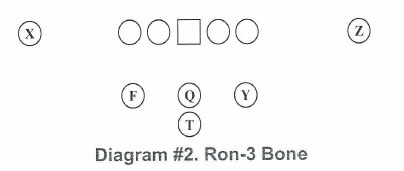 Our motion concept is simple. We have an AP, IP, or OP to signify our motion. The letters mean the type of motion. The "A" is across the formation, "I" is into the formation, and "0" is outside the formation. AP motion goes across the formation. IP motion goes into the formation, and OP motion goes outside the formation. To get the right player running the motion we put the first letter of the position on the motion. Yip- motion is the Y-receiver using motion into the balk If we want to move the tailback,
Our motion concept is simple. We have an AP, IP, or OP to signify our motion. The letters mean the type of motion. The "A" is across the formation, "I" is into the formation, and "0" is outside the formation. AP motion goes across the formation. IP motion goes into the formation, and OP motion goes outside the formation. To get the right player running the motion we put the first letter of the position on the motion. Yip- motion is the Y-receiver using motion into the balk If we want to move the tailback,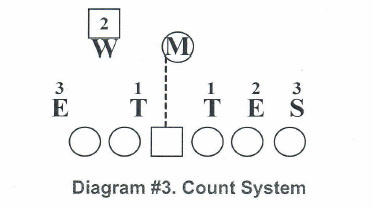 If no one aligns on the center's nose, he calls out the linebacker as the 0 defender. From the linebacker to the outside they number the defenders 1, 2, and 3. We number the defenders going both ways from the center.
If no one aligns on the center's nose, he calls out the linebacker as the 0 defender. From the linebacker to the outside they number the defenders 1, 2, and 3. We number the defenders going both ways from the center.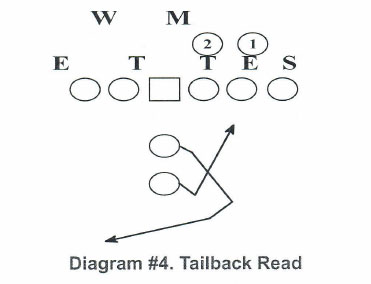
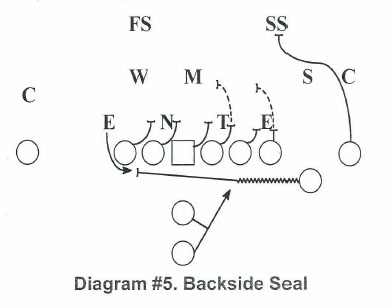 We can align him in the backfield and send him across the mesh to block the end. We can align him to the defensive ends side, motion him away, and bring him back in return motion.
We can align him in the backfield and send him across the mesh to block the end. We can align him to the defensive ends side, motion him away, and bring him back in return motion.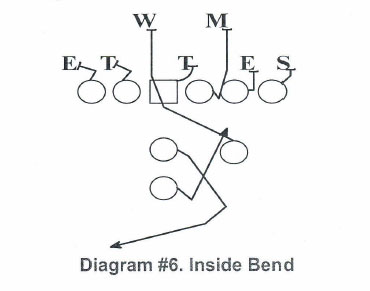 They are not stepping into gaps and area blocking. If the backside guard has a 3-technique, he turns him out. The backside tackle turns out on the backside defensive end. The H-back leads up on the backside linebacker and the tailback bends the ball to him. The tailback must sell the play going downhill to the playside.
They are not stepping into gaps and area blocking. If the backside guard has a 3-technique, he turns him out. The backside tackle turns out on the backside defensive end. The H-back leads up on the backside linebacker and the tailback bends the ball to him. The tailback must sell the play going downhill to the playside.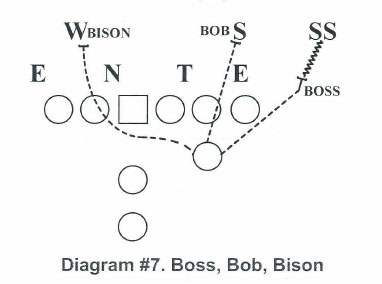 The H-back does not need to align as shown in the diagram. He can come from any place in the formation. We can use motion and get him anywhere we choose. We like to run the "Bob" call against the 3-3 stack defense. We widen the splits in the offensive line to spread the stacks and run the isolation on the outside linebacker.
The H-back does not need to align as shown in the diagram. He can come from any place in the formation. We can use motion and get him anywhere we choose. We like to run the "Bob" call against the 3-3 stack defense. We widen the splits in the offensive line to spread the stacks and run the isolation on the outside linebacker.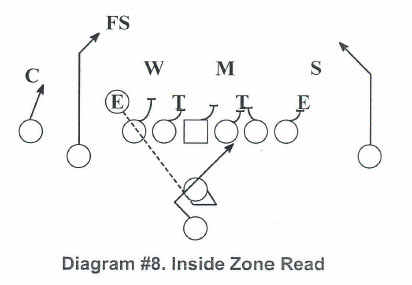 Since we are reading the left defensive end, the tailback's first step is with his left foot. He takes three steps and pivots at a 45 degree angle to align to the hole. The quarterback reads the defensive end and pulls the ball or leaves it and we run the inside zone.
Since we are reading the left defensive end, the tailback's first step is with his left foot. He takes three steps and pivots at a 45 degree angle to align to the hole. The quarterback reads the defensive end and pulls the ball or leaves it and we run the inside zone. They tell the defensive end to key the offensive tackle. If the offensive tackle goes inside, the defensive end runs the heel line of the offensive tackle. The defense tells the Will linebacker to scrap off the butt of the defensive end and take the quarterback. We run what we call a "deuce" scheme. We send a second blocker for the weakside linebacker.
They tell the defensive end to key the offensive tackle. If the offensive tackle goes inside, the defensive end runs the heel line of the offensive tackle. The defense tells the Will linebacker to scrap off the butt of the defensive end and take the quarterback. We run what we call a "deuce" scheme. We send a second blocker for the weakside linebacker.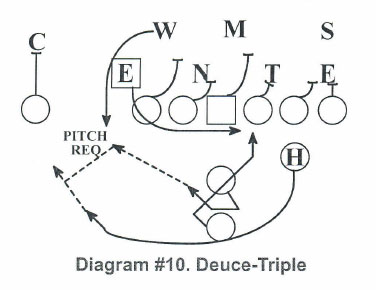 On this call, the deuce blocker takes a drop step, comes outside the mesh of the quarterback and tailback, and becomes the pitch-back on the option. The quarterback reads the defensive end. If he comes up field, the quarterback gives the bail on the inside zone. If the defensive end chases the tailback, the quarterback pulls the ball, and options the Will backer as his pitch key.
On this call, the deuce blocker takes a drop step, comes outside the mesh of the quarterback and tailback, and becomes the pitch-back on the option. The quarterback reads the defensive end. If he comes up field, the quarterback gives the bail on the inside zone. If the defensive end chases the tailback, the quarterback pulls the ball, and options the Will backer as his pitch key.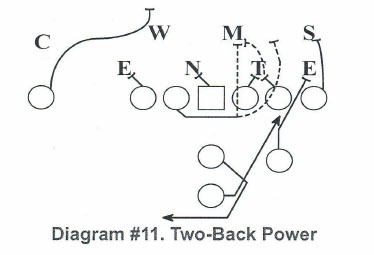 My favorite play is the power play. There are many different ways to run it. The offensive line does not block the end man on the line of scrimmage. We kick him out or read him. We run one-back, two-back, or three-back power plays.
My favorite play is the power play. There are many different ways to run it. The offensive line does not block the end man on the line of scrimmage. We kick him out or read him. We run one-back, two-back, or three-back power plays.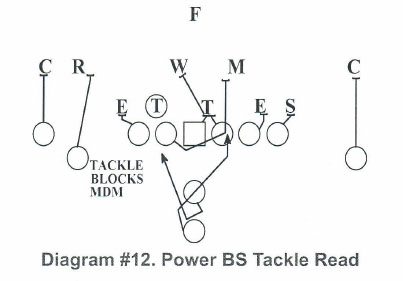 The offensive line blocks a gap scheme. The backside guard is pulling for the Mike linebacker. He wraps through the first playside window. The offset back kicks out the outside linebacker.
The offensive line blocks a gap scheme. The backside guard is pulling for the Mike linebacker. He wraps through the first playside window. The offset back kicks out the outside linebacker.
